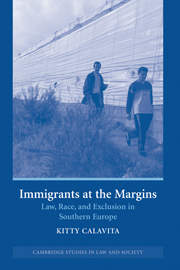Book contents
- Frontmatter
- Contents
- List of tables
- Preface
- Acknowledgments
- Maps
- 1 Introduction
- 2 Legal framework and the wayward “legs of law”
- 3 “Useful invaders”: the economics of alterité
- 4 Integrating the “Other”
- 5 The Everyday dynamics of exclusion: work, health, and housing
- 6 Fuel on the fire: politics, crime, and racialization
- 7 Conclusion: immigrants and other strangers in the global marketplace
- Notes
- Bibliography
- Index
3 - “Useful invaders”: the economics of alterité
Published online by Cambridge University Press: 04 July 2009
- Frontmatter
- Contents
- List of tables
- Preface
- Acknowledgments
- Maps
- 1 Introduction
- 2 Legal framework and the wayward “legs of law”
- 3 “Useful invaders”: the economics of alterité
- 4 Integrating the “Other”
- 5 The Everyday dynamics of exclusion: work, health, and housing
- 6 Fuel on the fire: politics, crime, and racialization
- 7 Conclusion: immigrants and other strangers in the global marketplace
- Notes
- Bibliography
- Index
Summary
The president of the Banca d'Italia issued a blunt warning: “Italy needs immigrants.” His counterparts in Spain have raised similar alarms, with even the Spanish government conceding, “Immigration is a desirable phenomenon.” This sometimes reluctant acknowledgment of the importance of immigrants hinges in part on the dangerously low birthrates in these Catholic countries, and related fears that their social security systems cannot survive the shrinking revenues and expanding expenses associated with their rapidly aging populations.
Italy and Spain have birthrates of less than 1.2 per couple (compared to 1.5 for the rest of the EU), far below replacement level. By the middle of this century, they will be the two oldest countries in the world, with a median age of over 54. Population declines threaten the very survival of many small towns and villages – even the legendary Italian hilltowns of Tuscany and Umbria. Writing of the demise of these towns, one journalist wrote: “Defiant through the centuries, they survived the Roman Empire, plagues, barbarians, two World Wars, famines, earthquakes, depressions and huge migrations to New York, Boston, and Philadelphia. But [this] new peril is more threatening than any of the previous ones.”
Immigrants are counted on to offset these trends. Under the headline, “It Will Be Immigrants Who Save Italians' Pensions,” the Banca d'Italia president pointed out that only a hefty infusion of young immigrants can ward off the impending crisis in Italy, where pensioners already outnumber active workers and the pension system is $44 billion in debt.
- Type
- Chapter
- Information
- Immigrants at the MarginsLaw, Race, and Exclusion in Southern Europe, pp. 48 - 74Publisher: Cambridge University PressPrint publication year: 2005

